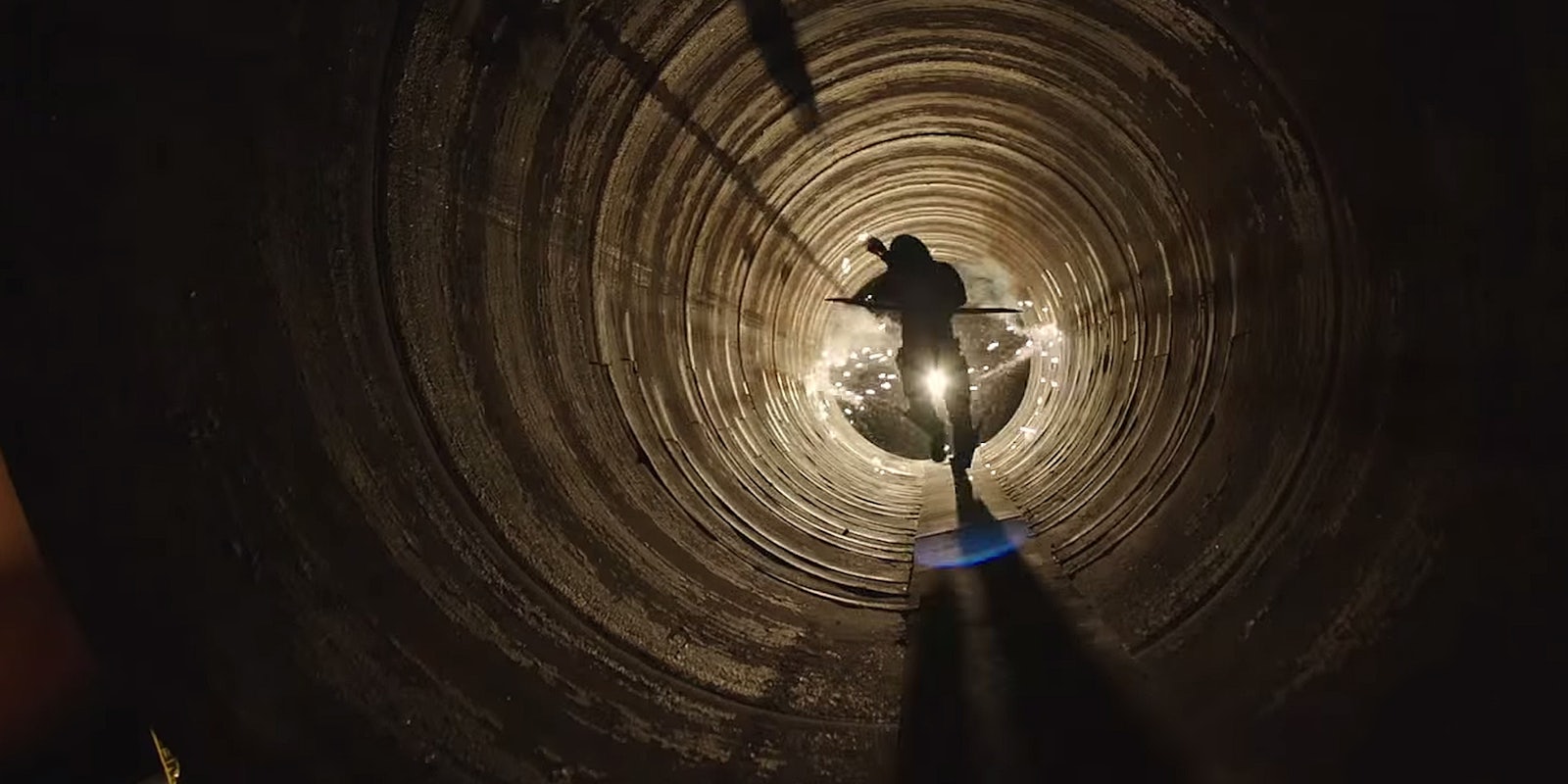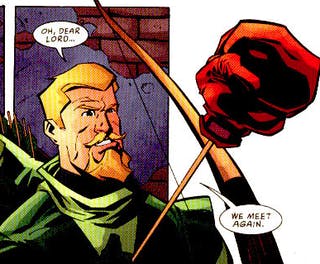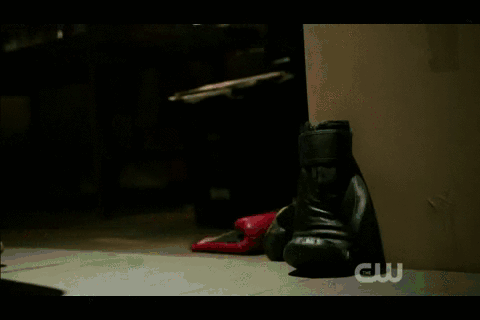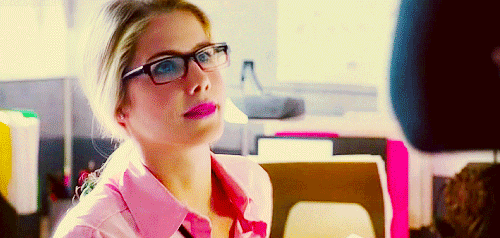On Sunday, the CW renewed eight of its series, including the superhero show Arrow.
The show is currently in the middle of its third season, depicting the adventures of Oliver Queen, a.k.a. the Green Arrow. With all the attention that Marvel is getting right now for Agents of S.H.I.E.L.D. and Agent Carter, it’s important to point out that, thanks to Arrow, DC Comics is doing something few expected from it just a few years ago: competing formidably with its larger rival in the superhero television space.
If you aren’t already watching Arrow, it’s time to change that. Here are the five biggest reasons why comic fans and DC novices alike should dive into Oliver Queen’s world.
1. It’s just as intense as superhero television should be
Stephen Amell, the Canadian actor who plays Oliver Queen, often says that Arrow’s stunt and special effects teams are the best in the business. There may be no good quantitative way to measure that claim, but watching Arrow week in and week out, there’s no doubt that the stunt work and special effects are better than almost anything else on television. When you watch superhero TV shows, you expect a certain level of intensity. With its expertly choreographed duels and logistically headache-inducing group fight scenes, Arrow takes televised action up several notches.
It would be easy to insert several GIFs of Arrow’s best fight scenes into this article, but that would spoil the surprise of actually watching those fights play out on screen. Suffice it to say that the season 2 finale, “Unthinkable,” contains one of the most technically sophisticated large-scale fights ever attempted on television and some of the most gripping hand-to-hand combat in the entire series. The massive battle is so complex that you’ll assume it’s mostly CGI—but it’s all real. And that’s a testament to how seriously Arrow takes its action scenes.
In its 5th Annual Season Finale Awards, held in May 2014, Entertainment Weekly readers picked the Arrow stunt team in the “Most Likely to Earn Someone an Emmy Nomination” category. Previewing the finale to EW, Amell said, “If we can’t win the stunt Emmy for this episode, then the system is broken, for sure.” (Arrow did not win, as if we needed any more proof that the award system was hopelessly flawed.)
2. It’s keenly aware of the DC Comics mythology
The Oliver Queen of Arrow may be more of a brooding type than the generally plucky verdant archer from the comics, but outside of characterization, Arrow embraces the DC universe. Groups, businesses, cities, and characters from the comics appear or are mentioned in almost every episode. Sometimes it’s as simple as a reference to Big Belly Burger, a DC Comics fast-food chain. Other times, the series builds entire story arcs out of the origin stories for well-known second-tier characters. (Again, no direct spoilers, but think about colors and birds and combinations thereof.) One reference to an iconic Batman villain was as understated as a shot of the back of someone’s head. Blink and you’ll miss it—but if you’re a comic fan, you probably won’t.
Marc Guggenheim, one of Arrow’s three executive producers, has written for DC Comics for decades. He wrote The Flash for several years beginning in 2006. (In the fall of 2014, the CW began airing The Flash, a spinoff of Arrow focusing on the young scientist Barry Allen. The network is clearly keen to expand its DC Comics offerings, and a spinoff series based on another famous superhero may be in the works.) Guggenheim and his team are well aware of the legions of comic-book readers tuning into their show to see live-action adaptations of major events in the DC universe, and while they can’t promise direct recreations of those storylines, they want to bring the trappings of the comic-book world to the screen whenever possible.
The executive producers of Arrow have received many questions over the years, but until recently, one of the most common refrains was, “When are we going to get the boxing-glove arrow?” The comic version of the Green Arrow has used an entire arsenal of so-called “trick arrows” over the years, but nothing amused fans as much as the boxing-glove arrow, seen below in a comic panel that appeared in an io9 Q&A with DC Comics Chief Creative Officer Geoff Johns.
Asked if the boxing-glove arrow would ever make it onto Arrow, Johns replied, “They think about it all the time. Again, the people on the show love the source material, so they’re going to try everything they can to get it in there. If they can actually pull it off it some way, it’ll be awesome.”
That was February 2013. In November 2014, Johns and millions of fans got their wish.
This is a show that embraces the entire pantheon of DC creative potential: the drama and the comedy alike.
3. The characters are compelling—and you’ll be hooked
Anyone who has experience with fandom knows about shippers. Holding out hope for a relationship between two as-yet-unlinked characters is one of the most painful crosses that diehard fans must bear. Early in its first season, Arrow introduced and began cultivating perhaps the most excruciating unfulfilled romance since Rose and the Tenth Doctor in Doctor Who.
In “Lone Gunmen,” the third episode of season 1, Arrow fans—and Oliver himself—met Felicity Smoak.
Emily Bett Rickards was only supposed to appear in that one episode as an IT specialist at the company Oliver inherited from his late father, but her performance—in particular, her chemistry with Amell—convinced the Arrow creative team that she needed to become a regular. Since then, Felicity has been instrumental in every operation that Oliver has undertaken to protect the people of Starling City. Along the way, however, Arrow has treated us to numerous reminders of why “Olicity” is not meant to be.
After episode after episode of will-they-or-won’t-they, Olicity almost happened at one point. But the aftermath was a painful reminder of why separation was the safest bet, if not the most rewarding one for the characters or viewers.
Televised relationship drama on its own is perilous: Give too much and supply will exceed demand; give too little and demand may not materialize emphatically enough. Whet the audience’s appetite, but pull back at the last moment. Arrow has this in spades. But what Arrow also gets right is the balance between character and story. Starling City is a metropolis under siege from many threats, and in each episode, it’s only a matter of time before Oliver must don his hood and leave his attachments behind. By the middle of the first season, Arrow’s writers will have viewers hooked on Oliver’s many relationships, platonic and otherwise.
It’s also worth noting that the women on the show are not two-dimensional comic-book love interests. Oliver’s mother, Moira, is a scheming matriarch whose evolving plan for her family and her city will have viewers alternately admiring and despising her. Oliver’s sister, Thea, undergoes a dramatic transformation in the second and third seasons. As Arrow’s third season continues to unfold, she is following a path that few viewers could have imagined back in season 1. Both Oliver’s ex-girlfriend Laurel Lance and her sister Sara have or soon will have alter-egos that add substantial depth to what could have been disappointingly stereotypical roles. Lastly, there’s Felicity. As of the third season, her relationship with Oliver is being tested by a new player in Starling City, and the past three years of crime-fighting are beginning to take their toll. Token geek girl, she is not.
Several other great characters join Oliver on his adventures, like his driver-turned-bodyguard-turned-conscience John Diggle and the Starling City detective Quentin Lance (yes, Lance—that makes things interesting). As Oliver’s relationships with these and other characters grow and change, longtime fans will see him be forced to choose between his humanity and his hood in dramatic ways. Superheroism has its price, and as Arrow starts to tick off those costs one by one, viewers who invest in the unfolding drama will feel Oliver’s pain acutely. Oliver Queen can’t have it all, but anyone who starts the series from the first episode and watches all the way through will be pushing for him to try anyway.
4. It’s not afraid to take risks—get attached to characters at your peril
To put it bluntly, at least two of the characters mentioned in this article have already met their demise in surprising and devastating ways. One of their deaths in particular still haunts Amell, who calls it one of the most memorable scenes he’s ever filmed. This is not a show that takes drama lightly. Viewers are encouraged to develop attachments to characters, because this is what keeps interest in the show so high, but they should always remember that their favorite secondary character could be one twist away from death. By the middle of the third season, it’s hard to see how Oliver keeps going after all he’s lost.
The buildup of these characters, the potential they offer for future storytelling, makes it all the more difficult to say goodbye to them. This in turn makes it all the more amazing to watch Oliver power forward. The more he loses, the more he seems willing to give up for his family, his friends, and his city. If the show is principally about Oliver and his journey, it is nonetheless built atop and grounded in Oliver’s many relationships.
The Oliver of this show is frequently compared to Batman. Like the Caped Crusader, Oliver’s brooding demeanor and history of loss inform his every move. But whereas Batman almost puritanically avoids attachments, preferring to prowl the rooftops alone, Oliver’s commitment to keeping Starling City safe stems in part from understandable self-interest. He still has family and friends living in the city. He wants to keep them safe. Several of them regularly fight crime with him. In short, Oliver’s relationships matter far more to his adventures than do Batman’s.
5. The flashbacks create a unique and compelling format
In the series premiere, Oliver Queen returns to Starling City after spending five years on and around a hellish island. To say those five years changed him is a dramatic understatement. He left on a boat trip as a carefree, unambitious playboy and returned from his trials as a determined killer with a list of names to cross off. He then transforms from Oliver Queen into the Vigilante, from the Vigilante into the Hood, and from the Hood into the Arrow. Along the way, flashbacks to the island and nearby adventures illuminate his growth. The audience begins to understand what has prepared Oliver Queen for a life of slinging arrows at bad guys.
The flashbacks are one of Arrow’s most important tools. The show is at its best when it pairs those flashbacks with present-day drama to show the parallels between Oliver’s choices and the lessons that have informed his decisions. Through the flashbacks, which reveal things that no one else knows about Oliver, the audience becomes his confederate. Only Oliver and the viewers know certain things about his formative years. This makes Oliver’s subsequent development even more rewarding to watch.
By using flashbacks to show Oliver making mistakes and learning lessons, Arrow one-ups its rival DC show, Fox’s Gotham, in a crucial way. One of the promises of Gotham was that it would use the city to show Batman fans what made Bruce Wayne decide to put on the cape. Fox wasn’t so much showing people Batman’s origin story as it was showing people Gotham’s. Arrow’s flashbacks allow the producers to show people Oliver’s origin story in both the past and the present, mixing his costumed adventures with memories of his trials. This is something that Gotham can never do, and on Arrow, the payoff is a thoroughly explored origin story. Even Smallville, the show that pioneered live-action superhero origin stories, couldn’t have imagined a storytelling premise this multifaceted.
For these reasons and more, Arrow is the best superhero show on television. It may not get the same level of attention as Marvel’s Agents of S.H.I.E.L.D., but its producers and writers know what they’re doing—and so does the CW. Arrow’s third season returns on Jan. 21. The newly announced fourth season will premiere this fall.





